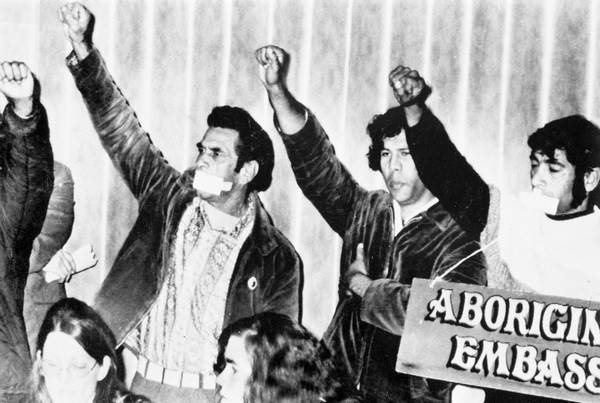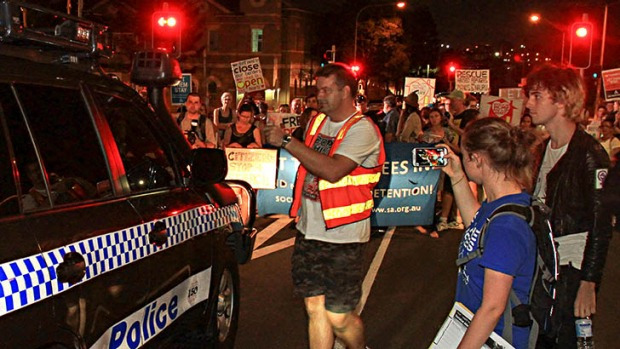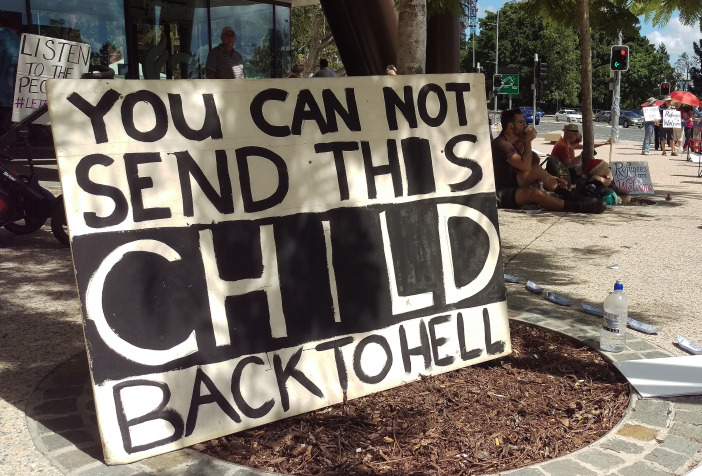It seems that the vast majority of Australian progressive opinion is against a plebiscite on same-sex marriage. It will be divisive, costly and give conservative forces like the Australian Christian Lobby and its handful of parliamentary backers significantly more air than they deserve. Many campaigners would have the government simply pass the changes through parliament, and avoid this mess.
#LetThemStay Fieldnotes 3: What happened? What were the different elements of the event and how did they fit together?
Recently I posed twelve questions to help myself understand the events of recent weeks and help think through what has happened and where we are all going. This is my first attempt to answer them. I doubt I will answer – in writing – all twelve.
The answers I provide are necessarily subjective and partial. I only attended the vigil twice. I welcome disagreement and corrections. However I think that subjective and qualitative reflections on collective experience are a vital part of how we understand them.
I think there were three separate elements: the decision by staff at the Lady Cilento Children’s Hospital to not discharge Asha on the basis that Nauru didn’t qualify as somewhere safe to return to; the vigil which became a blockade of sorts faced with the possibility of Border Force taking Asha; and the wave of symbolic actions and stunts where people proclaimed #LetTheStay with the aim of generating and circulating imagery in the media (social and otherwise).
#LetThemStay Fieldnotes 2: Updates and Meeting reflections

Since the announcement that Asha would be placed in community detention, to return to Naura at some future moment, Peter Dutton stated that ‘over the last couple’ of weeks another boat had been turned back to Sri Lanka and Julian Burnside has reported another example of the violent abuse of asylum seekers by guards on Nauru . This news of business as usual should steel us about the nature of the terrain we are on; and sharpen our diagnosis that the mandatory detention of refugees as part of an aggressive process of reinforcing the border is (rather than simply a moral failing of conservative politicians) structural and systemic to the order of society itself. (My comrades who read Agamben often quote him that the camp is the ‘biopolitical nomos of the planet’)(2000, 45).
The latest news I have heard (so it might not be true) is that Asha and both her parents are now in transitory accommodation whilst community detention is being organised. The government has also made an undertaking that for at least the next month it will provide 72 hours’ notice to lawyers before any of the 267 are deported. St John’s Cathedral is shoring up its commitment to providing sanctuary with Love Finds A Way providing non-violent direct action training on Wednesday 2nd March from 7pm-10pm at the Cathedral.
Continue reading “#LetThemStay Fieldnotes 2: Updates and Meeting reflections”
#TheRighttotheCity: The Battle for Bowen Hills, 1972-5
Recent discussions on the Brisbane left have brought the idea of the ‘Right to City‘ back to public prominence. A spirited conference was recently held to discuss the issue, and the reclaiming of public space outside the Lady Cilento Children’s Hospital to stop the deportation of baby Asha has led to some reflecting on spaces of encounter and politicisation. So, we have decided to put up a few posts over the next few weeks and months considering the successes and failings of previous Brisbane movements who fit within what we would now call the Right to the City
On Monday, 3rd of June 1973 twenty police with a sledgehammer descended on 13 Markwell Street, Bowen Hills. They were responding to a group of protestors, who had occupied the building a day earlier. Promised to the housing commission, it had been left idle by the State Government’s Main Roads Department (MRD) for months, who had resumed it as part of freeway construction. That the house was not needed for freeway construction in the short term meant little, the house still had to go. As activists put it at the time, “The Main Roads Department’s determination to see this house remain empty or demolished has no rational foundation.”
So, three activists decided to do what the government wouldn’t – occupy the house, make it habitable, and turn it over to one of the many families then being made homeless by Government freeway construction. The cops, who didn’t appreciate such moral arguments, “grabbed the three and forcibly threw them out the door”.
Continue reading “#TheRighttotheCity: The Battle for Bowen Hills, 1972-5”
#LetThemStay Fieldnotes 1
The decision by the Lady Cilentro Children’s Hospital to not discharge the infant Nepalese refugee Asha back to Nauru and the emergence of a vigil in solidarity was an important and inspiring event. The experience of it was radically different from the protest-politics-as-usual that typify the activist repertoire in Brisbane. Now that Asha has been discharged into community detention, and is facing a very uncertain and probably deeply unpleasant future, there is a desire to make sense of what has happened, what is going on and what does it mean?
Living The Dream ‘Dominant Society Needs A Slap in the Face’: Sovereignty Solidarity & Decolonisation

In this episode of Living the Dream Dave (@withsobersenses) chats with Camilla and Eliza from Sovereignty Solidarity.
Sovereignty Solidarity describes their Facebook page as follows:
‘We aim to support First Nations(FN) initiatives for self determination, sovereignty, treaties, and moving forward. We take action based on our understanding of these perspectives and aim to concretely support FN initiatives. We are a non-FN specific page because we believe non-FN peoples have specific de-colonisation work that we need to do, and that the burden for this should be placed on FN peoples. We welcome input, criticism and support from FN people’
Camilla and Eliza have provided the following relevant links:
First Nations
brisbane aboriginal-sovereign embassy
Non-First Nations
Eliza would like the following qualification added to the title and the podcast: ‘sometimes dominant society needs a slap in the face, like on the 26th January, but sometimes dominant society needs a more gentle-gentle approach. Learning about the history of this country, the legacy of colonialism and our transplanted place on this land can be a hard journey and if people need empathy through this process it is other non FN people who should do this work.’
Listen here: Download this episode (right click and save)
or subscribe:
“Malcolm X Exploded in My Mind”: The Transnational Imagination of Australian Indigenous Activists
My latest on the international imagination of Australian indigenous activists, then and now.
 The Black Power salute given by Aboriginal activists Chicka Dixon, Paul Coe, and Bob McLeod in 1972. Source: Audio Visual Archive, Australian Institute of Aboriginal and Torres Strait Islander Studies, Canberra. Courtesy of the National Museum Australia website.
The Black Power salute given by Aboriginal activists Chicka Dixon, Paul Coe, and Bob McLeod in 1972. Source: Audio Visual Archive, Australian Institute of Aboriginal and Torres Strait Islander Studies, Canberra. Courtesy of the National Museum Australia website.
Jon Piccini
University of Queensland
Follow on Twitter @JonPiccini
Recently, an upturn in indigenous struggles in Australia have seen the legacies of colonialism and genocide forced back onto the national radar. Protests against the closure of indigenous communities, the continued forced removal of Aboriginal children by welfare agencies, and the birth of youth-led groups like Warriors of the Aboriginal Resistance (WAR) are but a few examples of this. Instead of the sanitised government-sponsored campaign to ‘Recognise’ indigenous peoples in the Australian constitution, many of these activists are looking back to the global struggles of the 1960s and 1970s for their political inspiration.
View original post 960 more words

